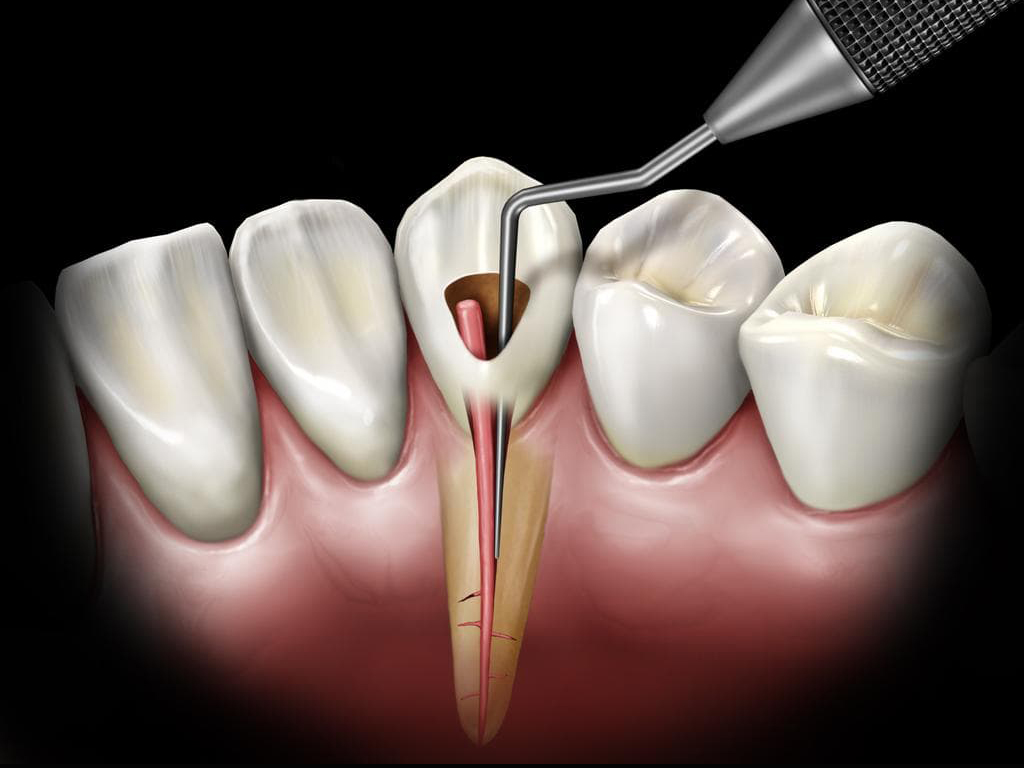What is Root Canal Treatment?
Root canal treatment, also known as endodontic therapy, is a dental procedure used to treat infection at the center of a tooth. This procedure involves removing the damaged or infected pulp, cleaning the inside of the tooth, and sealing it to prevent further infection.
- Purpose: Saves infected or damaged teeth
- Process: Removes damaged pulp, cleans tooth interior, seals tooth
- Outcome: Prevents tooth extraction

Why is Root Canal Treatment Necessary?
A root canal in Islamabad might be necessary if you have a severely decayed or infected tooth. The primary goal of this treatment is to save your natural tooth and prevent the infection from spreading to adjacent teeth.
- Prevention: Stops infection from spreading
- Restoration: Saves natural teeth from extraction
- Symptoms: Severe tooth pain, sensitivity, and swelling
Symptoms Indicating You Might Need a Root Canal
Recognizing the signs early can help you seek treatment before the problem worsens.
- Pain: Severe toothache when chewing or applying pressure
- Sensitivity: Prolonged sensitivity to hot or cold temperatures
- Discoloration: Darkening of the tooth
- Swelling: Tenderness and swelling in the nearby gums
How Does a Dentist Determine if You Need a Root Canal?
Dentists use various methods to determine if a root canal is necessary.
- Examination: Thorough dental exam and X-rays
- Testing: Pulp vitality tests to check for infection or damage
- Diagnosis: Based on symptoms, examination, and test results
The Steps Involved in Root Canal Treatment
Understanding the procedure can help you prepare mentally and physically.
Initial Consultation
- Assessment: Detailed examination and X-rays
- Discussion: Dentist explains the procedure and answers questions
The Procedure
- Anesthesia: Local anesthesia to numb the area
- Access: Dentist drills an opening to reach the pulp chamber
- Cleaning: Removes infected pulp and disinfects the root canals
- Filling: Canals are filled with a biocompatible material
- Sealing: Temporary or permanent filling is placed
Post-Procedure Care
- Pain Management: Prescription or over-the-counter pain relievers
- Follow-Up: Schedule a follow-up visit for further treatment if necessary
- Care Tips: Maintain good oral hygiene and avoid hard foods
How Painful is a Root Canal Treatment?
Many patients fear root canal treatment due to misconceptions about pain.
- Anesthesia: Ensures a pain-free experience during the procedure
- Discomfort: Some post-procedure discomfort, manageable with painkillers
- Relief: Most patients experience significant pain relief once the infection is treated
How Long Does a Root Canal Procedure Take?
The duration can vary based on the tooth's condition and complexity of the case.
- Single Visit: Simple cases may be completed in one visit
- Multiple Visits: Complicated cases may require two or more visits
- Time Frame: Each visit can last from 60 to 90 minutes
What to Expect After a Root Canal Procedure?
Understanding the recovery process can help you manage your expectations.
- Recovery: Mild soreness for a few days
- Diet: Soft foods and avoiding hard or sticky foods
- Hygiene: Continue with regular brushing and flossing
- Follow-Up: Regular dental check-ups to monitor healing
Risks and Complications of Root Canal Treatment
Like any medical procedure, root canal treatment has potential risks.
- Infection: Risk of re-infection if not properly sealed
- Breakage: Tooth may become brittle and fracture
- Discomfort: Temporary sensitivity or discomfort
Costs and Insurance Coverage for Root Canal Treatment
Understanding the financial aspect can help you plan accordingly.
- Cost Range: Varies based on tooth location and complexity
- Insurance: Often covered by dental insurance plans
- Out-of-Pocket: Check with your provider for specific coverage details
Alternatives to Root Canal Treatment
Exploring other options can help you make an informed decision.
- Extraction: Removing the tooth and replacing it with an implant or bridge
- Antibiotics: Temporary relief, but not a permanent solution
- Pulp Capping: For less severe cases, protecting the pulp with a cap
Preparing for a Root Canal Procedure
Being well-prepared can make the experience smoother.
- Information: Understand the procedure and ask questions
- Medication: Follow any pre-procedure instructions given by your dentist
- Rest: Ensure you are well-rested before the appointment
Types of Anesthesia Used in Root Canal Treatment
Knowing about anesthesia options can ease anxiety about the procedure.
- Local Anesthesia: Numbs the treatment area
- Sedation: Options for patients with dental anxiety
- General Anesthesia: Rarely used, for complex or multiple procedures
Driving After a Root Canal Treatment
Consider your post-procedure transportation needs.
- Local Anesthesia: Generally safe to drive home
- Sedation: Arrange for someone to drive you if sedatives are used
Post-Treatment Care for a Root Canal
Proper care can ensure a smooth recovery and long-lasting results.
- Hygiene: Maintain good oral hygiene practices
- Diet: Eat soft foods and avoid hard or sticky items
- Medication: Take prescribed medications as directed
Duration of Recovery After a Root Canal
Knowing the recovery timeline helps in planning your activities.
- Immediate: Some discomfort for a few days
- Long-Term: Full recovery in a few weeks, depending on the individual
Aesthetic Impact of a Root Canal Treatment
Understanding how your tooth will look post-treatment can alleviate cosmetic concerns.
- Appearance: Tooth may look slightly different if a crown is placed
- Whitening: Option to whiten teeth if discoloration occurs
Eating After a Root Canal Treatment
Dietary changes post-treatment are important for healing.
- Soft Foods: Initially stick to soft foods
- Avoidance: Hard, chewy, or sticky foods that may damage the tooth
- Hydration: Drink plenty of water to stay hydrated
Need for a Crown After a Root Canal
Exploring the necessity of additional dental work post-treatment.
- Strength: Crowns provide extra strength and protection
- Longevity: Helps the treated tooth last longer
- Appearance: Restores the natural look of your tooth
Handling Persistent Pain After a Root Canal
Knowing when to seek further treatment can prevent complications.
- Normal: Mild discomfort is common initially
- Persistent Pain: Contact your dentist if pain continues beyond a few days
- Re-Treatment: In some cases, additional treatment may be needed
Root Canal Treatment for Children
Understanding the specifics of pediatric root canals.
- Procedure: Similar to adults, with special considerations for young patients
- Comfort: Emphasis on making the child comfortable and reducing anxiety
- Outcome: Saves primary teeth until natural exfoliation
Foods and Activities to Avoid After a Root Canal
Specific guidelines ensure proper healing and prevent damage.
- Foods: Avoid hard, sticky, or chewy foods
- Activities: Avoid strenuous activities that might impact the treated area
- Care: Follow your dentist’s specific instructions
Success Rate of Root Canal Treatments
Knowing the effectiveness can build confidence in the procedure.
- High Success Rate: Most root canal treatments are highly successful
- Long-Term: Proper care extends the life of the treated tooth
- Follow-Up: Regular check-ups ensure ongoing success
Risks of Delaying Root Canal Treatment
Understanding the consequences of postponing treatment can motivate timely action.
- Infection Spread: Delay can lead to the infection spreading
- Pain Increase: Symptoms can worsen over time
- Tooth Loss: Increased risk of losing the tooth
Root Canal Treatment During Pregnancy
Special considerations for expectant mothers.
- Safety: Generally safe with proper precautions
- Timing: Best performed during the second trimester
- Consultation: Discuss with your dentist and obstetrician
Difference Between Root Canal and Tooth Extraction
Weighing the options to make an informed decision.
- Root Canal: Saves the natural tooth and eliminates infection
- Extraction: Removes the tooth, often requiring a replacement
- Considerations: Long-term benefits and personal preferences
Root Canal on a Previously Treated Tooth
Understanding re-treatment options if a root canal fails.
- Assessment: Dentist will evaluate the cause of failure
- Procedure: Similar to initial treatment, with additional steps if needed
- Outcome: High success rate for re-treatment
For those considering a root canal in Islamabad, Royal Cosmetic Surgeries offers comprehensive and compassionate care. Our experienced dental professionals ensure a comfortable and effective treatment experience. Contact us today to schedule your consultation and take the first step towards a healthier smile.














